For divers, Australia isn't just a destination—it's a dream. With coastlines touching three major oceans and thousands of miles of coral reefs, marine reserves, and rugged coastlines, there's no shortage of places to explore. Whether it's drifting alongside turtles, coming face-to-face with Great White Sharks, or discovering the hidden treasures of an underwater volcanic island, diving here is nothing short of spectacular. Let's take a plunge into four of Australia's best dive spots and meet the operators who can help you make the most of them.
1. Ningaloo Reef, Western Australia
Fringing the North West Cape coastline of Western Australia, the Ningaloo Reef stretches over 260 kilometres, creating a haven for marine enthusiasts. The reef's accessibility, often just meters from the shore, makes it an ideal spot for divers eager to explore a vibrant underwater world teeming with life.
Diving at Ningaloo is offers encounters with some of the ocean's most graceful residents. Green, Loggerhead, and Hawksbill turtles are a common sight here, often spotted gliding gracefully above the coral gardens or resting on sandy patches. From April to November, the chance to swim alongside majestic Manta Rays adds to the allure. These elegant giants can often be seen sweeping through the water in search of plankton, their vast wings cutting through the ocean currents with ease.

The reef's thriving ecosystem is also home to over 300 coral species and approximately 500 species of fish, including some endemic species that attract divers from across the globe. These include the Australian Anenomefish (endemic to north-west Western Australia), Sailfin Catfish and Ningaloo Maskray. Among the brightly coloured coral gardens, you'll find a variety of sponges, tree corals, and Gorgonian fans. Fish life abounds, with Parrotfish, Angelfish, Butterflyfish, and larger species such as Groper, Coral Trout, and Trevally providing an endless display of motion and colour. The underwater environment also hides some elusive creatures like the well-camouflaged Leafy Scorpionfish, shy Moray Eels, and tiny, intricately patterned Nudibranchs.
While diving at Ningaloo Reef offers its own array of wonders, the region's seasonal visitors add an extra dimension to the underwater experience. From March to August, the reef attracts the world's largest fish, the Whale Shark, which can grow up to 18 meters in length. These gentle giants are drawn to Ningaloo's plankton-rich waters, creating the unique opportunity to snorkel alongside them as they glide gracefully through the open ocean. Later in the year, from August to late October, Humpback Whales make their presence known, with more than 30,000 migrating to the area. Guests can enjoy snorkel tours where they may swim near these magnificent creatures as they rest, calve, and play in the warm, sheltered waters.
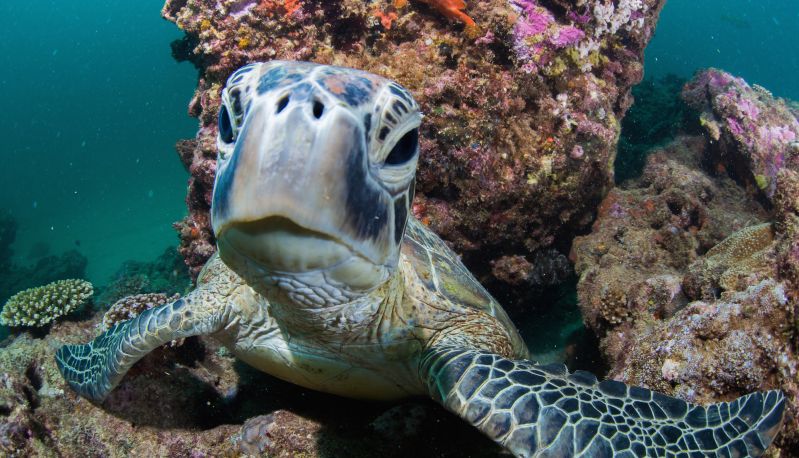
For a dive that feels like a journey into another world, head to the Muiron Islands. The western side of the islands features a mix of hard and soft corals, the latter displaying a stunning palette of bright oranges, pinks, and blues. Here, divers are treated to sights of Potato Cod, colourful reef fish, and even the occasional shark. On the eastern side, where shallower waters and hard corals dominate, you'll often spot turtles lazily drifting through the currents.
Mark Ferguson, co-founder of Exmouth Dive & Whalesharks Ningaloo, describes the Muiron Islands as "a really accessible site for both snorkellers and divers," with diverse coral formations and marine life at every turn. The area's signature blend of sea fans, sponges, and tree corals sets the stage for encounters with everything from Nudibranchs and Moray Eels to the friendly Batfish that glide effortlessly through the water.
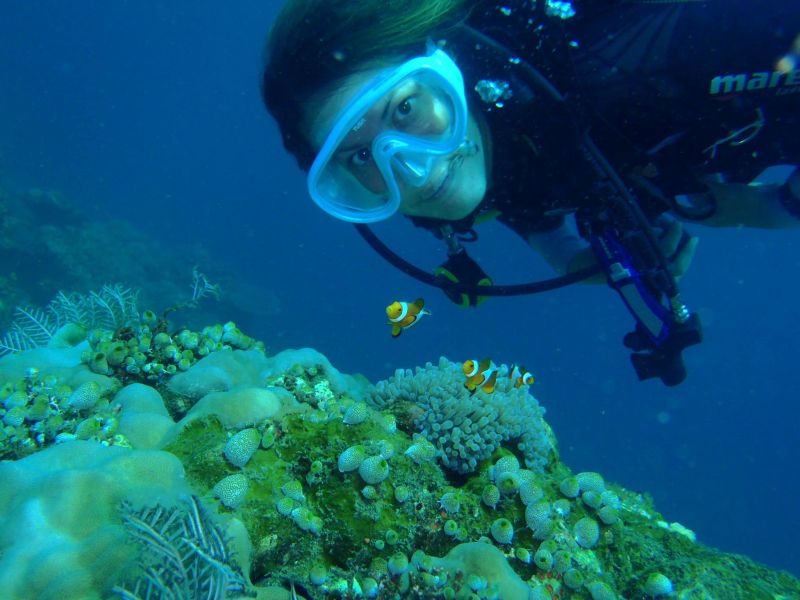
Quick facts
Iconic species: Green Turtle, Loggerhead Turtle, Hawksbill Turtle, Manta Ray, Parrotfish, Clownfish, Butterflyfish, Angelfish, Wrasse, Potato Cod, Batfish, Whitetip Reef Shark, Moray Eel, Nudibranches, Anenomes, Bottlenose Dolphin, Whale Shark, Humpback Whale, Dugong.
When to visit: March through October.
Recommended tour: Ningaloo Reef Dive Tour (Full day - shared or private)
2. Christmas Island, Australian External Territory
Christmas Island, a remote paradise in the Indian Ocean, is often referred to as the 'Galapagos of the Indian Ocean' due to its remarkable biodiversity and abundance of endemic species. The island's natural beauty extends beyond its lush forests and unique wildlife; beneath the surface lies one of Australia's most awe-inspiring dive destinations. The fringing reef and dramatic underwater drop-offs are just a stone's throw from the shore, offering divers extraordinary experiences in waters that can reach visibility up to 50 meters. With 88 coral species and more than 650 fish species, Christmas Island promises encounters with marine life that range from the commonplace to the truly rare.

Divers are greeted with the island's signature underwater landscapes: immense drop-offs plunging down several kilometres into the abyss of the Java Trench, the Indian Ocean's deepest trench. The reef slopes are adorned with vibrant Gorgonian fan corals and intricate plate coral formations, creating a kaleidoscope of colours that make for spectacular underwater photography. During the dry season (April to October), the northwestern coastline becomes a haven for divers, with its sheltered waters and pristine coral gardens. When the wet season arrives (November to March), diving shifts to sites that offer opportunities to spot whale sharks, which occasionally cruise by, and manta rays, adding to the thrill of discovery.

Indian Ocean Experiences offers packages to Christmas Island that include trips to some of the region's 60 dive sites, providing a range of options for divers of all skill levels. The adventure typically starts at Flying Fish Cove, where divers can plunge into crystal-clear waters to explore stunning coral gardens, dramatic drop-offs, and mysterious underwater caves. The island's reef is teeming with life: expect to see species like surgeonfish, wrasse, butterflyfish, angelfish, groupers, parrotfish, and reef sharks. The occasional encounters with turtles, dragon moray eels, and even bump-head parrotfish add to the spectacle.
With dives scheduled in the morning, there's plenty of time to also explore Christmas Island's terrestrial wonders in the afternoon. Indian Ocean Experiences makes it easy for guests to maximize their time, combining diving with guided tours that showcase the island's spectacular wildlife, landscapes, and cultural heritage.

Quick facts
Iconic species: Green Turtle, Hawksbill Turtle, Whale Shark (seasonal/opportunistic), Surgeonfish, Wrasse, Butterflyfish, Angelfish, Reef Shark, Red Crab, Robber Crab, Christmas Island Frigatebird, Golden Bosun, Abbott's Booby, Brown Booby, Red-tailed Tropicbird, Christmas Island Goshawk, Christmas Island Hawk-owl.
When to visit: Year-round. The best conditions are during the dry season (June - August), when seas tend to be more calm.
Recommended tour: Dive Christmas Island (7 days - shared or private)
3. Frankland Islands, Queensland
The Frankland Islands, a breathtaking archipelago off the coast of Far North Queensland, offers a spectacular escape into the Great Barrier Reef Marine Park, a UNESCO World Heritage site. Located about 10 kilometres offshore and 45 kilometres southeast of Cairns, this group of uninhabited islands - including Normanby, High, Russell, Round, and Mabel—is renowned for its stunning natural beauty and extraordinary marine biodiversity. Surrounded by pristine fringing reefs, the islands provide a dazzling underwater environment filled with vibrant hard and soft corals, schools of colourful fish, and the possibility of spotting turtles, octopuses, dolphins, and even the occasional dugong.
Visitors to the Frankland Islands are treated to idyllic sandy beaches fringed with coastal grasses, pandanus, and coconut trees. You will encounter diverse ecosystems, including lush rainforests, rocky outcrops, and mangrove habitats. These ecosystems support a variety of birdlife, making the islands an essential nesting ground for species like the Little Tern, Beach Stone-curlew, Pied Imperial Pigeon, and Crested Tern. Notably, Normanby Island is famous for its exceptional snorkelling opportunities, featuring geological formations that tell the story of a once-connected mainland. The surrounding cool water channels provide refreshing sea temperatures, contributing to exceptionally healthy corals.
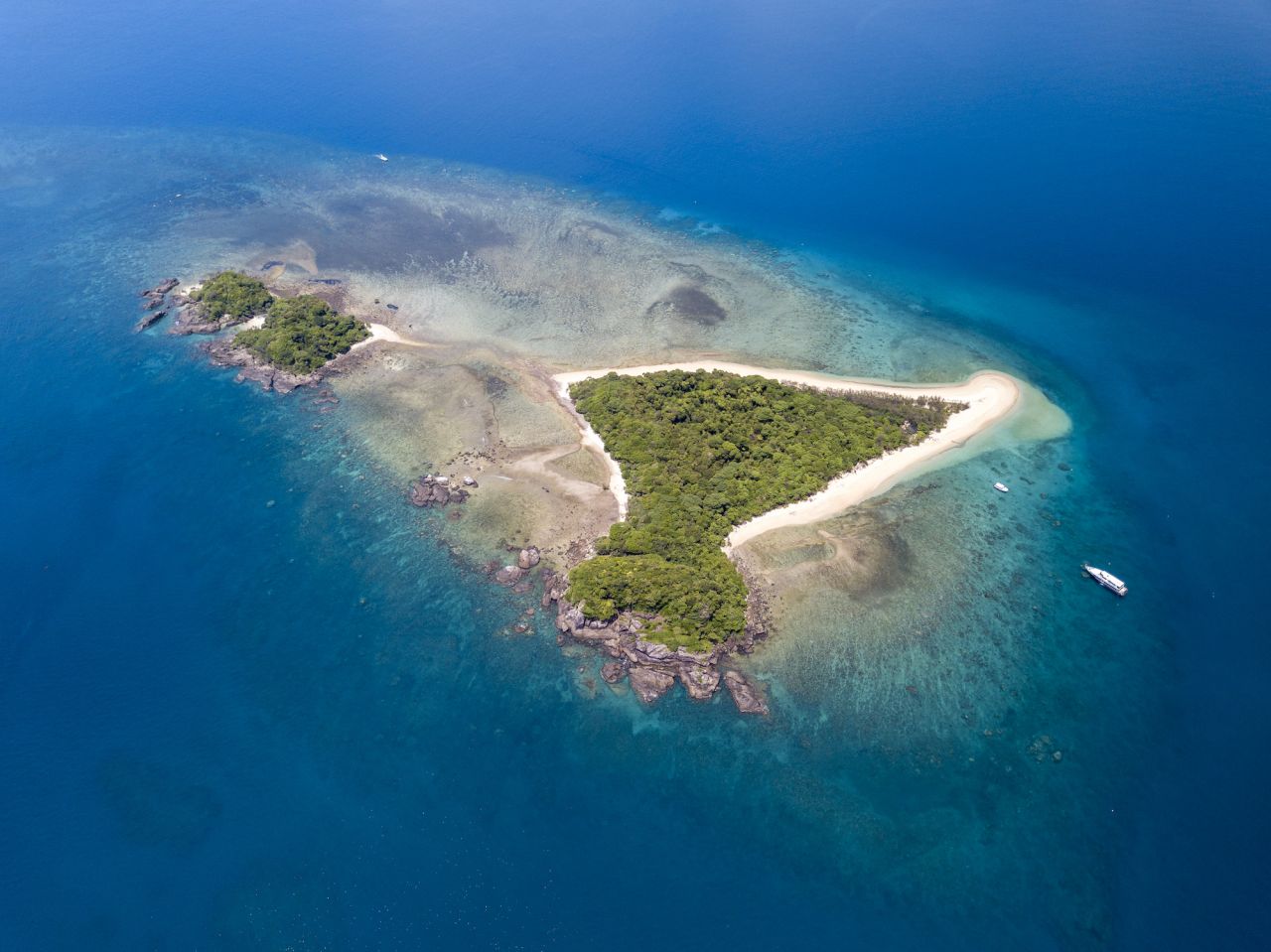
Frankland Islands Reef Cruises offers exclusive access to the stunning Frankland Islands National Park, with an experience that leaves the crowds behind. The underwater world here is a treasure trove of marine life, including sea turtles, nudibranchs, giant clams, butterflyfish, angelfish, parrotfish, damselfish, and stingrays. Not to mention, you'll encounter over 200 species of coral, including the charming ocellaris clownfish (Nemo), found in the island's rare jewel-blue anemones.
Thanks to its unique geographic location and the influence of cool water channels, the Frankland Islands boast exceptional water quality and visibility. Being just a short 10-kilometre crossing from the mainland, this destination offers the shortest sea journey for any Great Barrier Reef day trip. Tour numbers are intentionally limited to just 100 people per day, ensuring a more personalized and less crowded experience.
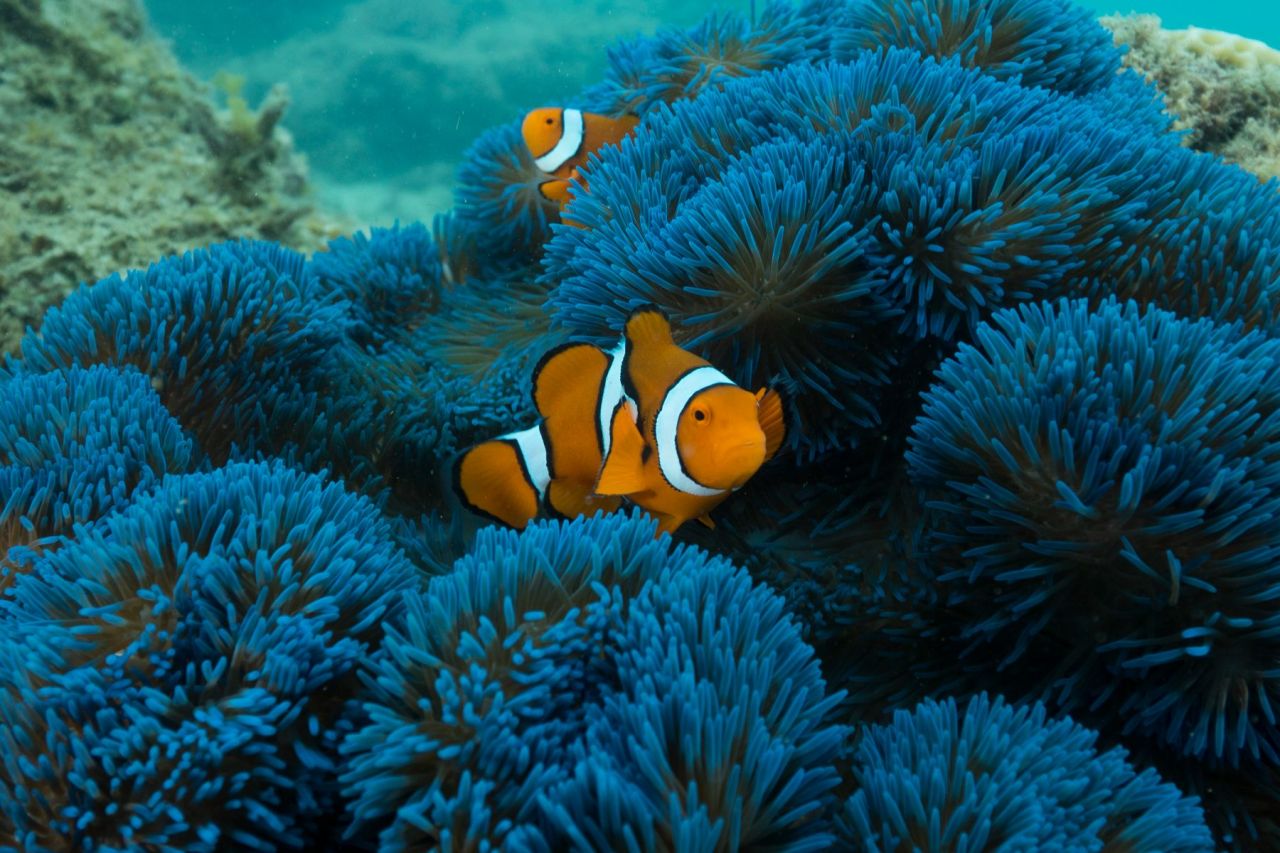
If you're eager to try diving at the Great Barrier Reef, the friendly and experienced crew at Frankland Islands Reef Cruises is ready to help you start your underwater adventure! As a PADI 5-star Dive Centre, they have years of experience in diving instruction. No previous scuba diving experience is required—if you're comfortable in the water and have no medical conditions that preclude you from diving, you can usually participate in an introductory dive. You'll receive thorough briefings, tuition, and skills practice at the surface to ensure your dive is safe and amazing. During your intro dive, under the expert supervision of our instructors, you'll descend to 12 meters (40 feet) below the surface and enjoy the unique marine life that makes Frankland Islands so special.
Please note that only introductory dives are offered from the Frankland Islands (at additional cost). Please enquire directly as this must be arranged at the time of booking and prior to the tour. If you are looking for more advanced and certified dive touring, please check out the Spirit of Freedom liveaboard options or TUSA Reef Tours.
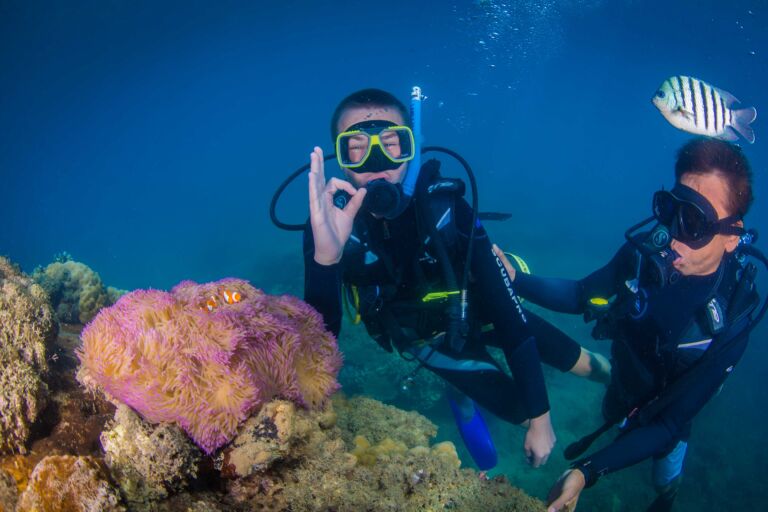
Quick facts
Iconic species: Green Turtle, Hawksbill Turtle, Manta Ray, Dugong, Beach Stone-Curlew, Pied Imperial Pigeon, Little Tern, Crested Tern, Giant Clam, Nudibranch, Angelfish, Parrotfish, Ocellaris Clownfish.
When to visit: Year-round. While the tour operates all year, the best time is during the 'dry season' (April - October) when humidity is lower and weather conditions are generally more pleasant.
Recommended tour: Frankland Islands Reef Cruises Day Tour (1 day - shared) - please enquire about diving, as this must be pre-arranged.
4. Eyre Peninsula, South Australia
The Eyre Peninsula is Australia's ultimate temperate aquatic playground, showcasing a breathtaking array of landscapes that include striking coastlines, vast sand dunes, rugged offshore islands, and secluded coves. This region is not just a visual delight; it's also a hub for incredible marine encounters, making it a top destination for those seeking adventure in the water.
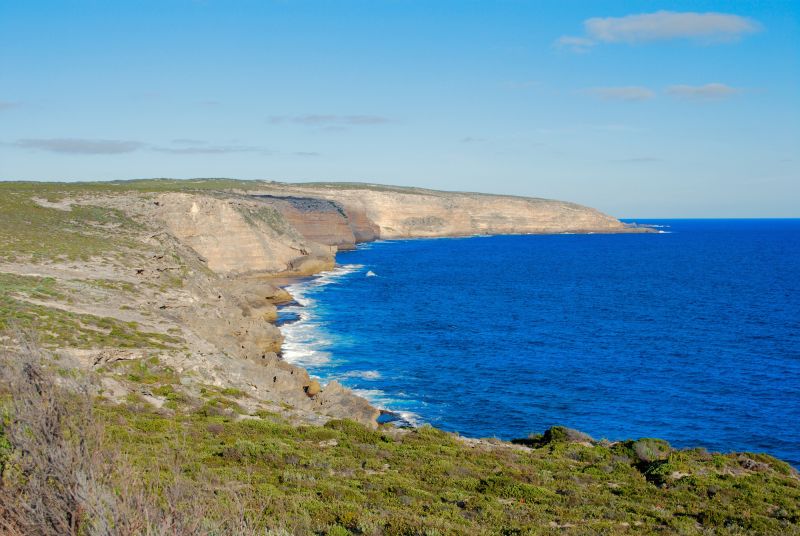
The pristine waters of the Eyre Peninsula serve as a sanctuary for some of Australia's most unique and curious marine creatures. Visitors have the chance to interact with dolphins, Australian sea lions, giant cuttlefish, leafy sea dragons, southern right whales, and, of course, the awe-inspiring great white shark. This region has gained a reputation for offering unforgettable opportunities to connect with these wild marine animals, allowing guests to gain a unique perspective on their natural environments.
With over 2,000 kilometres of coastline, the Eyre Peninsula boasts endless vistas of the rugged Great Australian Bight. Yet, the experiences extend beyond the shoreline. Venturing inland reveals distinctive rock formations, rich geological history, and a diverse array of flora and fauna. The Southern Eyre Peninsula is home to 270 species of birds and 1,900 native plant species, showcasing a variety of habitats that include coastal dune shrublands, mallee woodlands, and salt marshes.

Experience the thrill of diving with the Great White Shark combined with touring across the magnificent Eyre Peninsula, on a 2-day package offered by Australian Coastal Safaris. On the Great White Shark experience, you'll depart the Marina at 7 am, embarking on a scenic 2.5-hour cruise towards the Neptune Islands. As you glide along the edge of Port Lincoln National Park and through Thorny Passage into the Southern Ocean, enjoy a light breakfast while keeping an eye out for playful dolphins and seabirds, including White-bellied Sea Eagles.
Upon arriving at the Neptune Islands, the skipper will find a sheltered spot to moor. Gather on the back deck for a comprehensive discussion on dive safety and procedures before descending into the underwater cage for an exhilarating 5-6 hours. No prior diving experience is required, allowing everyone to partake in the thrill of observing Great White Sharks up close. While you're in the water, you might also spot local wildlife, including Australian Sea-lions and Long-nosed Fur Seals, adding to the excitement of your adventure.
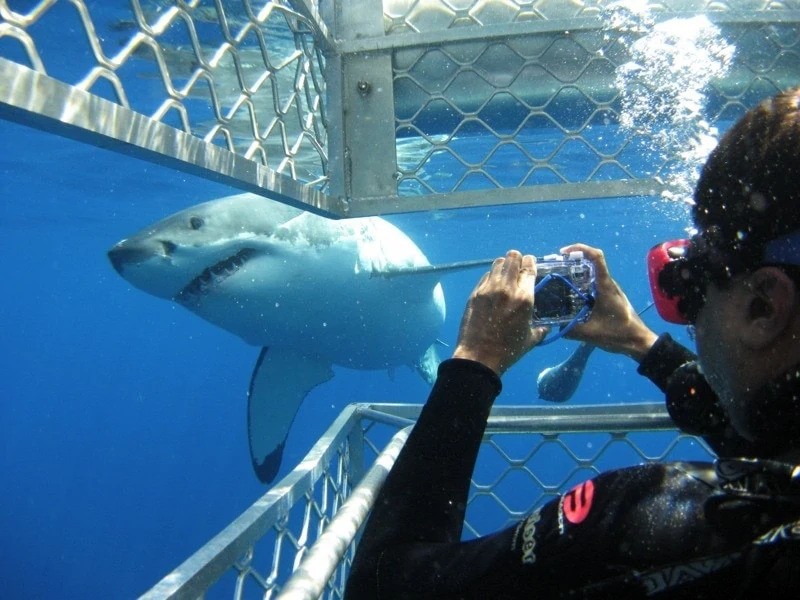
Quick facts
Iconic species: Great White Shark, Australian Sea-lion, Long-nosed Fur Seal, Western Grey Kangaroo, Koala, Emu, Australian Ringneck, Osprey, White-bellied Sea-Eagle, Wedge-tailed Eagle.
When to visit: Year-round. The water can be very cold in the winter (June - August).
Recommended tour: Great White Shark Cage Dive Packages (2 days - shared or private)

